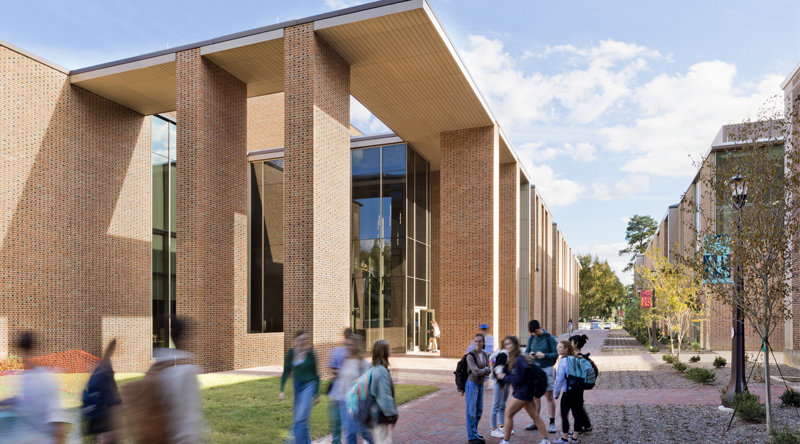William & Mary Expanding Fine and Performing Arts Quarter
By Eric Althoff
WILLIAMSBURG, Va.—HGA and architect-of-record Moseley Architects have jointly designed expansions to the College of William & Mary Fine and Performing Arts Quarter, which collectively fashions a new “front door” to the school’s arts complex that welcomes in students, staff and visitors. Whiting-Turner Contracting Company is acting as general contractor for the work, with other consultants on the project including theatrical experts Apeiro Design as well as acoustic and AV consultant Jaffe Holden.
Given that the university, America’s oldest, features a unique design aesthetic, the administrators of the school sought to have the newer arts buildings blend in with historical structures constructed of Flemish bond brick. Accordingly, HGA reimagined the 101,550-square-foot Phi Beta Kappa Memorial Hall as a modern home for dance and theater instruction, as well as for artistic displays and performances. The firm also designed an entirely new music building for the campus that is express-built with the best possible acoustics. The music building also features a percussion studio, rehearsal spaces as well as teaching studios.
Newer building materials complementing the Flemish bricks include wood and metal panels at Phi Beta Kappa Hall’s exterior as well as in the new music building. The design aesthetic also features glass that is meant to be “bird-safe” as well as minimize the amount of heat that will enter the interior during the summer months.
The designers, with an eye toward sustainability, aimed for LEED Silver Certification.
Rebecca Krull Kraling, planning principal at HGA, said it was her firm’s mission to meld a modern aesthetic with the historically familiar look and feel of the Arts Quarter at William & Mary.
“We took stock of the existing materials and motifs of the campus architecture and melded them with the arts complex’s contemporary aesthetic,” said Krull Kraling. “These buildings, striking in beauty and integrated in context, express to students, faculty, and the community the university’s dedication to nurturing, understanding, and promoting the arts in all forms.”
In a subsequent statement, Krull Kraling said that HGA wanted to assure school officials that they would create something new while respecting what has been on the campus for centuries prior.
“Each space and its function were considered individually, such as the need to block natural light in performance spaces and the need for privacy in rehearsal spaces,” she remarked. “The result was a variety of design methods to accommodate the needs of each department.”
With the first two phases now complete, movement on the next steps in the project can commence, though a final date of completion has yet to be announced.
HGA employs over 1,000 planners and architects at 12 offices nationwide. The company works in such design specialties as healthcare, tech, government and education.

